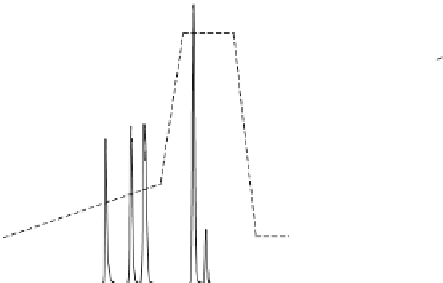Biomedical Engineering Reference
In-Depth Information
H
3
C
+
CH
3
N
H
3
C
H
3
C
N
O
O
O
O
OH
OH
littorine
(3)
ipratropium
(3)
O
CH
3
N
H
3
C
O
N
H
3
C
O
O
O
O
OH
atropine
(2)
(4) 5.3 min
cocaine
(4)
80
CH
3
O
O
H
3
C
N
D
3
C
N
O
O
O
O
OH
homatropine
(1)
d
3
-cocaine
(4)
+
CH
3
H
3
C
N
H
3
C
N
23
O
O
O
O
O
O
OH
OH
scopolamine
(1)
N-butyl-scopolamine
(5)
time [min]
Fig. 2
Simultaneous LC-MS/MS analysis of diverse tropane alkaloids. Analysis of plasma samples was
performed according to John et al. [
50
] using an Atlantis T3 C18 column (150 mm × 4.6 mm I.D., 5 m m)
in gradient mode (as indicated) with solvent A (0.1 % v/v FA) and solvent B (ACN/water 80:20 v/v
0.1 % v/v FA) at 1 ml/min and 30 °C. Detection was done by positive ESI MS/MS in MRM mode
simply on properties of columns, availability of columns in the laboratory, experi-
ence made with other applications and relationship to the providers and their special
offers. Therefore, a large variety of diverse RP-columns has been applied not breed-
ing any favourite. A representative chromatogram of a generic LC-ESI MS/MS
method for simultaneous quantification of 7 TA in plasma according to John et al.
[
50
] is shown in Fig.
2
.
Merely, the choice of column dimension demonstrates the awareness of cost reduc-
tion for organic solvents as well as analytical run time and thus of sample throughput
and economic efficiency. Only 2 % of published reports make use of a column with an
inner diameter (I.D.) as small as 1 mm [
12
] corresponding to a flow of 50 m l/min.
Columns with an I.D. of 2.0-2.1 mm are used in 48 % of reports determining a flow
between 200 and 500 ml/min and half of all applications is performed with a column I.D.
between 3.0 and 4.6 mm and a flow ranging from 500 to 1,000 ml/min (Tables
5
-
8
).
Typically used solvents contain ammonium acetate (NH
4
OAc) or ammonium
formate (NH
4
FA) in low millimolar concentrations to improve separation quality
and ionization efficiency in the positive ion mode. In 64 % of the reports referred to,
acetonitrile was used as organic modifier whereas methanol was applied in 36 % of
all applications (Tables
5
-
8
). As discussed above, the extent of sample clean-up















































































































